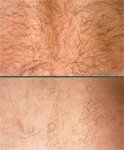- Case-Based Roundtable
- General Dermatology
- Eczema
- Chronic Hand Eczema
- Alopecia
- Aesthetics
- Vitiligo
- COVID-19
- Actinic Keratosis
- Precision Medicine and Biologics
- Rare Disease
- Wound Care
- Rosacea
- Psoriasis
- Psoriatic Arthritis
- Atopic Dermatitis
- Melasma
- NP and PA
- Skin Cancer
- Hidradenitis Suppurativa
- Drug Watch
- Pigmentary Disorders
- Acne
- Pediatric Dermatology
- Practice Management
- Prurigo Nodularis
- Buy-and-Bill
Article
Laser hair removal an attractive option for some male patients
Dermatologists whose practices offer laser therapy for hair removal are finding the procedure is becoming increasingly popular among men. "I would say that there is more awareness about hair removal as an option," says Vera Chotzen, M.D., dermatologist and associate director, Laser and Skin Surgery Center of Northern California, Sacramento, Calif.

Key Points

"I would say that there is more awareness about hair removal as an option," says Vera Chotzen, M.D., dermatologist and associate director, Laser and Skin Surgery Center of Northern California, Sacramento, Calif.
Better technology now exists to remove hair in areas such as the back, where hair tends to be thicker and coarser, according to Dr. Chotzen.
"It can accomplish removal of back hair in about half the time it used to take," she says. "The back can be treated in about 20 to 40 minutes, and it used to take about 90 minutes."
Laser limitations
Lasers are the state-of-the-art means to remove hair. Blond and white hair, however, cannot be removed with lasers.
"If someone has hair that is gray, white or blond, then lasers would not be an option," Dr. Chotzen says. Research is under way regarding treating lighter colored hairs, but such technology is not yet available.
"Although it is permanent hair reduction," Dr. Chotzen says, "it is unpredictable to know that there won't be a (hair) follicle stimulated to grow in the future."

"Laser hair removal has been indicated for years as a way of miniaturizing the hair, making the hair finer and smaller, and less likely to turn in on itself and develop pustulopapules," Dr. Chotzen says. "It works very elegantly for pseudofolliculitis barbae, which is much more common in men than in women."
Virtually any hair on the body, including nose hairs and ear hairs, can be treated with laser hair removal, she says, as long as it has pigment with which the laser can react and disable the hair from growing.
"Though we still recommend a patient not be tan before laser hair removal, devices have evolved such that you can choose a wavelength and treatment parameter that allows all skin types to be safely treated," says Dr. Chotzen. "Cooling the surface of the skin during treatment is also critical to protect from injury."
Results may vary
With each laser treatment, patients may see a 10 to 25 percent reduction in hair. If patients want to pursue the elimination of remaining hairs, they can continue treatments. Four to seven is the standard number of treatments, according to Dr. Chotzen, but for some patients, more treatment may be necessary.
"There is not a fixed interval (between treatments) for any one (body site)," Dr. Chotzen says. "Some areas grow differently. We have individuals come back when they see new growth. Although rare, some people do not respond. Individuals grow hair at different rates, and some people just grow faster than others."
For effective treatment, she says, the treatment area should be shaved before the procedure begins.
"The hair is shaved just prior to treatment," she says. "That is because you don't want the energy of the laser to react with the hair that sits on the surface. You want it to be delivered deeply, where the follicle grows."
Waxing tears the hair from the follicle and fails to offer permanent hair reduction.
"You will never have permanent hair reduction with just waxing," Dr. Chotzen says. "You get a longer interval before the hair figures out how to regrow, but it always does."
Side effects
Clinicians need to adjust laser treatment parameters to minimize inflammation on the skin to avoid secondary hyperpigmentation.
"Hypopigmentation can occur if the treatment is too aggressive for a person's skin type, causing injury to the surface of the skin," Dr. Chotzen says. "The devices that are being employed today, however, make these side effects (hypopigmentation and hyperpigmentation) concerns of the past for the most part."
Dr. Chotzen says nonlaser treatment for hair removal is being explored, and that there may be many more treatment options available in the future.
Disclosures: Dr. Chotzen reports no relevant financial interests.





